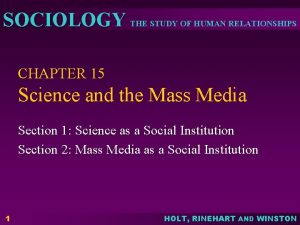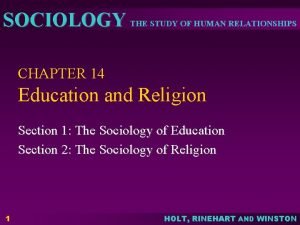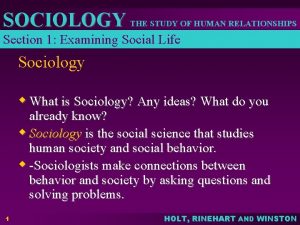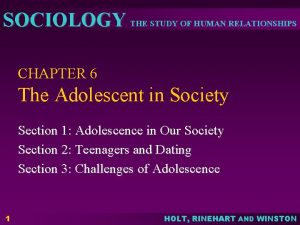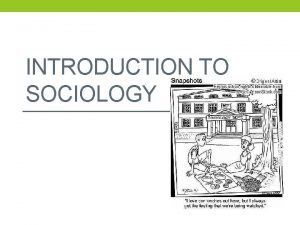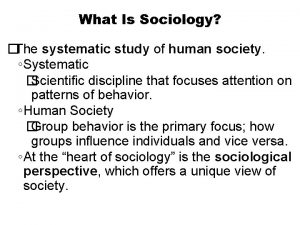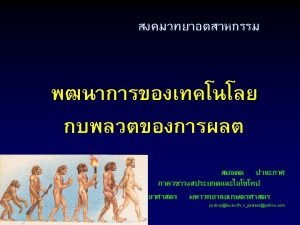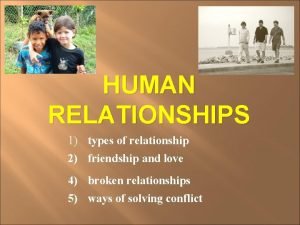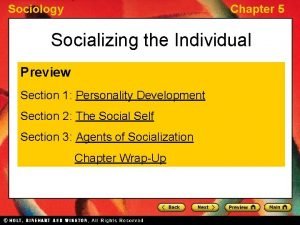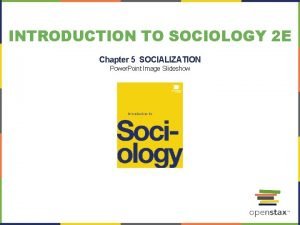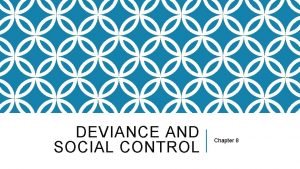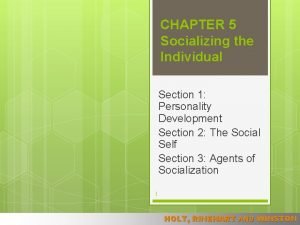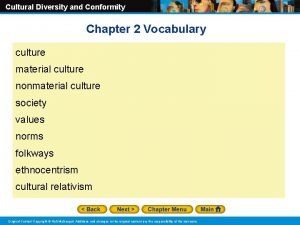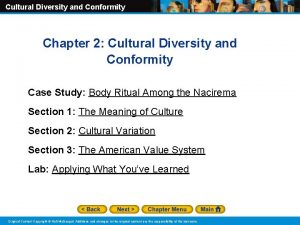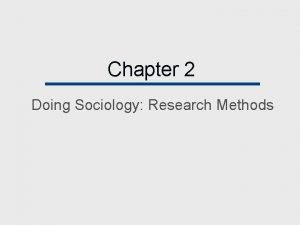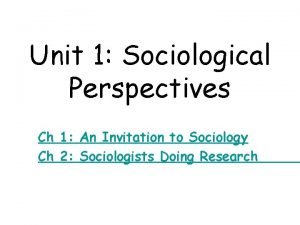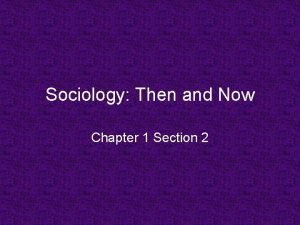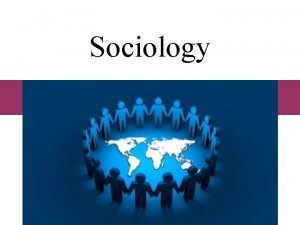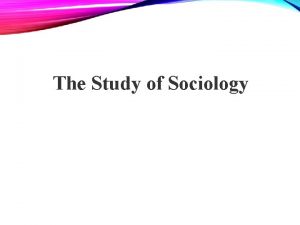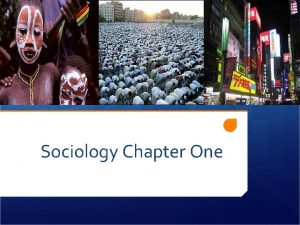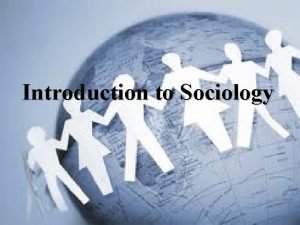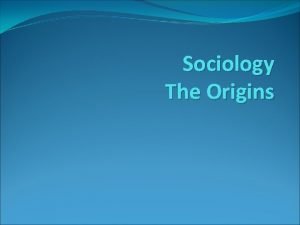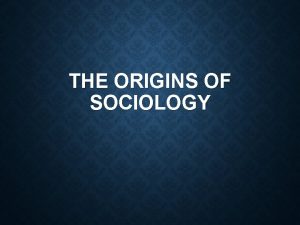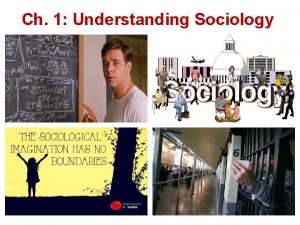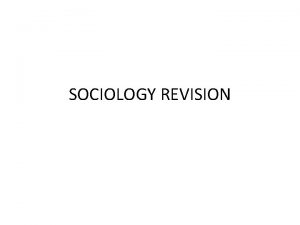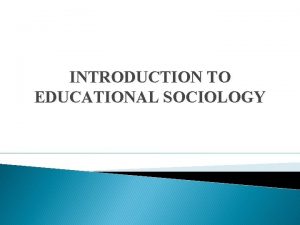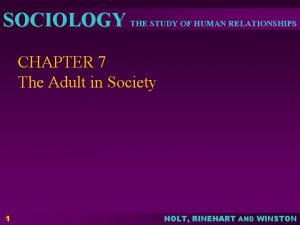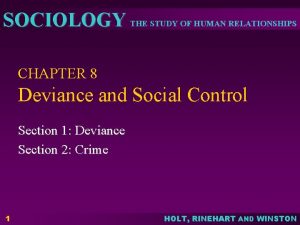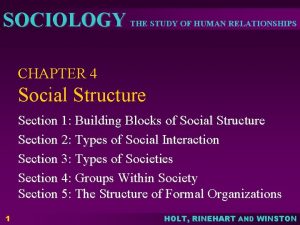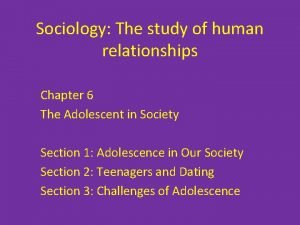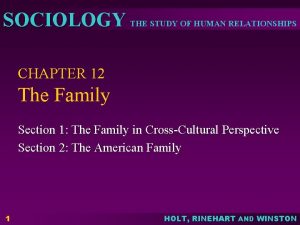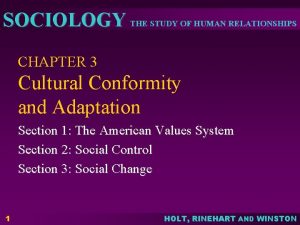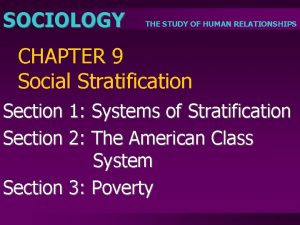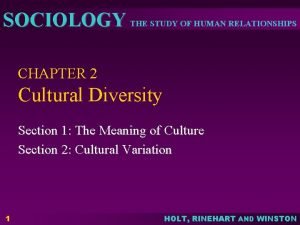SOCIOLOGY THE STUDY OF HUMAN RELATIONSHIPS CHAPTER 11










































































- Slides: 74

SOCIOLOGY THE STUDY OF HUMAN RELATIONSHIPS CHAPTER 11 Gender, Age, and Health Section 1: Gender Section 2: Age and Disability Section 3: Health 1 HOLT, RINEHART AND WINSTON

SOCIOLOGY THE STUDY OF HUMAN RELATIONSHIPS Section 1: Gender Objectives: w Analyze how gender roles affect the opportunities available to men and women in society. w Explain how gender roles are affected by socialization. 2 HOLT, RINEHART AND WINSTON

SOCIOLOGY THE STUDY OF HUMAN RELATIONSHIPS What is Gender? w Gender: comprises the behavioral and psychological traits considered appropriate for men and women: VS. w Sex: Biological identity HOLT, RINEHART AND WINSTON

SOCIOLOGY THE STUDY OF HUMAN RELATIONSHIPS Universal? w Sex characteristics are SAME in ALL societies. w Gender traits …are socially created and vary from culture to culture. HOLT, RINEHART AND WINSTON

SOCIOLOGY THE STUDY OF HUMAN RELATIONSHIPS Gender Roles and Identity: w Gender roles: w The specific behaviors and attitudes that a society establishes for men and women. w. EX: w. Women: child-care and domestic duties w. Men: Economic support and physical safety for family. HOLT, RINEHART AND WINSTON

SOCIOLOGY THE STUDY OF HUMAN RELATIONSHIPS What are sociologists concerned about? w Gender identity: w The awareness of being masculine or feminine as those traits are designed by culture. w However, cultural values influence gender identity and roles…have changed over the years. HOLT, RINEHART AND WINSTON

SOCIOLOGY THE STUDY OF HUMAN RELATIONSHIPS Between Cultures: Back to FRONT of handout! w Margaret Mead studied 3 New Guinea societies…discovered differences in culture. HOLT, RINEHART AND WINSTON

SOCIOLOGY THE STUDY OF HUMAN RELATIONSHIPS Tchambuli Society: w Men & women care for children. w Women provided food for family. w Women were bossy and efficient. w Men were gossipy and artistic. w Men wore cosmetics and curled hair. HOLT, RINEHART AND WINSTON

SOCIOLOGY THE STUDY OF HUMAN RELATIONSHIPS Mundugumor Society: w Aggressiveness was the norm for men AND women. HOLT, RINEHART AND WINSTON

SOCIOLOGY THE STUDY OF HUMAN RELATIONSHIPS Arapesh Society: w Both men AND women were expected to be passive and emotionally warm. HOLT, RINEHART AND WINSTON

SOCIOLOGY THE STUDY OF HUMAN RELATIONSHIPS What does this mean? w Gender roles are socially created rather than biologically based. HOLT, RINEHART AND WINSTON

SOCIOLOGY THE STUDY OF HUMAN RELATIONSHIPS Gender Identity and Socialization: w Learn appropriate gender-role behavior through socialization. w Begins at birth. w HOW? HOLT, RINEHART AND WINSTON

SOCIOLOGY THE STUDY OF HUMAN RELATIONSHIPS Is this nursery rhyme true today? What are little boys made of? Frogs and snails, And puppy-dogs’ tails, That’s what little boys are made of. HOLT, RINEHART AND WINSTON

SOCIOLOGY THE STUDY OF HUMAN RELATIONSHIPS Expectations of Little Boys: w Adventuresome w Aggressive w Physically active w Good at math and science w Encouraged to prepare for career HOLT, RINEHART AND WINSTON

SOCIOLOGY THE STUDY OF HUMAN RELATIONSHIPS What are little girls made of? Sugar and spice And all that is nice, That’s what little girls are made of. HOLT, RINEHART AND WINSTON

SOCIOLOGY THE STUDY OF HUMAN RELATIONSHIPS Expectations of Little Girls: w Polite, gentle, passive w Excel in reading and social sciences w Creative in arts w Look for marriage and family. w HOWEVER, more young women encouraged to pursue careers. HOLT, RINEHART AND WINSTON

SOCIOLOGY THE STUDY OF HUMAN RELATIONSHIPS w. The family is the most powerful agent of socialization!! HOLT, RINEHART AND WINSTON

SOCIOLOGY THE STUDY OF HUMAN RELATIONSHIPS Gender Roles and Social Inequality: w Women: w Adult years in pregnancy/nursing babies. w Took on roles allowed them to stay close to home. w Men: w Required strength and travel away from home base. w Hunters, traders, warriors w Gained much prestige…source of power within group. Patriarchy: men are dominant over women. HOLT, RINEHART AND WINSTON

SOCIOLOGY THE STUDY OF HUMAN RELATIONSHIPS Conflict Perspective on Gender Roles: w Gender roles = reflection of male dominance. w Through their control of economic and political spheres of society, men have established laws and customs that project their dominant position. w In so doing, men have blocked women's access to power. HOLT, RINEHART AND WINSTON

SOCIOLOGY THE STUDY OF HUMAN RELATIONSHIPS w Sexism: w The belief that one sex is by nature superior to the other. w Can become a self-fulfilling prophecy: w. People who believe that women are in some way incapable of occupying positions of power make choices based on this belief. **Copy Image from marker board!** w. Result lack of women in business, political, and professions. HOLT, RINEHART AND WINSTON

SOCIOLOGY THE STUDY OF HUMAN RELATIONSHIPS Gender Inequality in the United States: The Women’s Movement Education The World of Work The Political Arena HOLT, RINEHART AND WINSTON

SOCIOLOGY THE STUDY OF HUMAN RELATIONSHIPS The Women’s Movement: w Sexes were socially, politically, and economically equal. w Suffrage: the right to vote. w Nineteenth Amendment (1920) HOLT, RINEHART AND WINSTON

SOCIOLOGY THE STUDY OF HUMAN RELATIONSHIPS Betty Friedan’s book The Feminine Mystique w She REJECTED the notion that women were content with roles of wife and mother. w She argued that the “feminine mystique” – the glorification of these roles – was simply a ploy to keep women in a secondary positions in society. w Women began to demand greater opportunities and fairer treatment. HOLT, RINEHART AND WINSTON

SOCIOLOGY THE STUDY OF HUMAN RELATIONSHIPS Other gains in equality: w Congress passed several acts outlawing gender discrimination in education and in the workplace. HOLT, RINEHART AND WINSTON

SOCIOLOGY THE STUDY OF HUMAN RELATIONSHIPS Education: w In today’s American education: w 57% women make up in total college population. w 56% women earning all bachelor's degrees awarded. HOLT, RINEHART AND WINSTON

SOCIOLOGY THE STUDY OF HUMAN RELATIONSHIPS Differences in Degrees: w Men: w Engineering, physical science, architecture. w Women: w Education, humanities, library science. HOLT, RINEHART AND WINSTON

SOCIOLOGY THE STUDY OF HUMAN RELATIONSHIPS What About Graduate School? w More women attending graduate school. w Women make up more than 57% of those enrolled in graduate courses. w 58% earn Master’s degrees awarded each year. w HOWEVER, w Women are LESS likely to pursue doctoral or professional degrees. Turn to pg. 269 HOLT, RINEHART AND WINSTON

SOCIOLOGY THE STUDY OF HUMAN RELATIONSHIPS What about Athletics? 1970 s: w Funding for women’s athletics practically nonexistent at most coeducational colleges and universities! w Female College athletes: 16% w Female High school athletes: 8% HOLT, RINEHART AND WINSTON

SOCIOLOGY THE STUDY OF HUMAN RELATIONSHIPS w Education Amendment Act of 1972: w Bans discrimination on the basis of gender in any program- including athletics – at any educational institution receiving federal funds. HOLT, RINEHART AND WINSTON

SOCIOLOGY THE STUDY OF HUMAN RELATIONSHIPS Results: w About 40% of all college athletes are women. w HOWEVER: w Less than ¼ of funding for college sports goes to women's athletics w Female athletes receive less than one third of available scholarship money. HOLT, RINEHART AND WINSTON

SOCIOLOGY THE STUDY OF HUMAN RELATIONSHIPS The World of Work: w Wage gap have changed among women: w The level of women’s income relative to that of men. w Glass ceiling: w The invisible barrier that prevents women from gaining upper-level positions in business. HOLT, RINEHART AND WINSTON

SOCIOLOGY THE STUDY OF HUMAN RELATIONSHIPS What does sociologist Arlie Hochschild say? w Working wives work a second shift: w Have household duties to complete. w What about husbands? : w Normally, do NOT volunteer to help. w May purposely make a mess in hope that will not be asked again. w On average, women in U. S have at least 10 hours per week less leisure time than men. HOLT, RINEHART AND WINSTON

SOCIOLOGY THE STUDY OF HUMAN RELATIONSHIPS The Political Arena: w Women are MORE LIKELY to vote in elections! w However, more men hold political positions. w Society is more accepting of women leaders: w EX: Hillary Clinton, Condoleezza Rice, etc… HOLT, RINEHART AND WINSTON

SOCIOLOGY THE STUDY OF HUMAN RELATIONSHIPS Age & Disability Chapter 11: 2 HOLT, RINEHART AND WINSTON

SOCIOLOGY THE STUDY OF HUMAN RELATIONSHIPS Section 2: Age and Disability Objectives: w Discuss the effect that the aging of the population is having on society. w Explain how the aging of the population is affecting the life chances of older Americans. 35 HOLT, RINEHART AND WINSTON

SOCIOLOGY THE STUDY OF HUMAN RELATIONSHIPS Ageism: w The belief that one age category is by nature superior to another age category. w EX: TV commercials use elderly people for over the counter medications, dentures, insurance, burial plans, etc…. HOLT, RINEHART AND WINSTON

SOCIOLOGY THE STUDY OF HUMAN RELATIONSHIPS The Aging World: w About 606 million people aged 60 and older worldwide. w Europe: oldest region of the world. w Africa: youngest region of the world HOLT, RINEHART AND WINSTON

SOCIOLOGY THE STUDY OF HUMAN RELATIONSHIPS Graying of America: w The phenomenon of the growing percentage of elderly Americans as part of the total U. S. population. Check out pg. 273 HOLT, RINEHART AND WINSTON

SOCIOLOGY THE STUDY OF HUMAN RELATIONSHIPS 2 main reasons for Graying of America 1. Advances in health care. 2. Variations in birthrates have changed the age structure of the U. S. HOLT, RINEHART AND WINSTON

SOCIOLOGY THE STUDY OF HUMAN RELATIONSHIPS Births in U. S. rose sharply in 1946 and stayed the same until 1960 s. (baby-boom generation) w Today’s Age: late thirties to mid-fifties. w By 2030, will increase elderly population nearly 70 million. HOLT, RINEHART AND WINSTON

SOCIOLOGY THE STUDY OF HUMAN RELATIONSHIPS HOLT, RINEHART AND WINSTON

SOCIOLOGY THE STUDY OF HUMAN RELATIONSHIPS The Politics of Aging: w Elderly have become both a political force and a topic of debate. HOLT, RINEHART AND WINSTON

SOCIOLOGY THE STUDY OF HUMAN RELATIONSHIPS Bringing needs of elderly to national level: w AARP (American Association of Retired Persons) w THE LARGEST special-interest group in the U. S. w Provides financial advice & health-care insurance plans. w Travel and prescription –drug discounts w Modern Maturity- magazine HOLT, RINEHART AND WINSTON

SOCIOLOGY THE STUDY OF HUMAN RELATIONSHIPS Concerns for Elderly: FYI w Social Security: w Funded by payroll or income taxes on workers, employers, the self-employed. w Current payroll taxes fund the benefits paid to current retirees. w Challenges: Declining birthrates and longer life expectancies mean fewer workers to support growing numbers of retirees. HOLT, RINEHART AND WINSTON

SOCIOLOGY THE STUDY OF HUMAN RELATIONSHIPS Concerns for Elderly: w Social Security: w Dependency ratio: the number of workers for each person receiving Social Security benefits. w 1960: 5 to 1 w 2030: 2 to 1 HOLT, RINEHART AND WINSTON

SOCIOLOGY THE STUDY OF HUMAN RELATIONSHIPS “Old-Old” Challenges: (85+) w Medicare: w Government-sponsored health-insurance plan for elderly Americans and Americans with disabilities. w Medicaid: w State and federally funded health-insurance program for low-income individuals. w FYI: these programs are the sole sources of health insurance for close to one quarter of elderly Americans. HOLT, RINEHART AND WINSTON

SOCIOLOGY THE STUDY OF HUMAN RELATIONSHIPS Is there hope for Social Security? w Raising retirement age w Cutting benefits w Increasing Social Security payroll taxes. HOLT, RINEHART AND WINSTON

SOCIOLOGY THE STUDY OF HUMAN RELATIONSHIPS Age Inequality in the United States: w Social Security have made older Americans financially secure at the expense of younger generations. w Poverty rate for elderly: 10. 2% w Poverty rate or general population: 11. 3% w Poverty rate for children under age 18: 16. 2 % HOLT, RINEHART AND WINSTON

SOCIOLOGY THE STUDY OF HUMAN RELATIONSHIPS w Elderly African Americans: 22% w Elderly Hispanics: 19% w Women are hit by poverty than are men! w Poverty levels increase with Hispanic & African American women. w Poverty levels often high among old-old (85+). HOLT, RINEHART AND WINSTON

SOCIOLOGY THE STUDY OF HUMAN RELATIONSHIPS Americans with Disabilities: w Cover a wide variety of conditions: w Physical disabilities w Chronic health impairments w Mental retardation w Mental illness w Visual, hearing, and speech impairments. w Blindness, deafness, and paralysis HOLT, RINEHART AND WINSTON

SOCIOLOGY THE STUDY OF HUMAN RELATIONSHIPS Prejudice & Discrimination: w Stereotypical belief that their disabilities make them incapable of doing productive work. w Result: High unemployment rate among disabled. w Receive government assistance, but still struggle financially. HOLT, RINEHART AND WINSTON

SOCIOLOGY THE STUDY OF HUMAN RELATIONSHIPS w Disabled struggled for civil rights. w All Handicapped Children Act of 1975: w. Guaranteed children with disabilities a public education geared toward their needs and abilities. HOLT, RINEHART AND WINSTON

SOCIOLOGY THE STUDY OF HUMAN RELATIONSHIPS ADA: w “Americans with Disabilities Act” (1990) w Address 4 main areas: 1. Employment: Illegal to discriminate against people with disabilities in hiring, promotion, and pay. 2. Public services: Transportation 3. Public accommodations: Hotels, restaurants, theaters, etc…. 4. Telecommunications: Telecommunications-relay services (TRS) w Hearing and speech impaired HOLT, RINEHART AND WINSTON

SOCIOLOGY THE STUDY OF HUMAN RELATIONSHIPS Chapter 11: Section 3 Health 54 HOLT, RINEHART AND WINSTON

SOCIOLOGY THE STUDY OF HUMAN RELATIONSHIPS Section 3: Health Objectives: w Describe the state of health care in the United States. w Identify some of the special health-care concerns of various segments of American society. 55 HOLT, RINEHART AND WINSTON

SOCIOLOGY THE STUDY OF HUMAN RELATIONSHIPS What are your THREE main concerns when you receive healthcare? ? ? HOLT, RINEHART AND WINSTON

SOCIOLOGY THE STUDY OF HUMAN RELATIONSHIPS We will focus on THREE Main Issues: Cost of Health Care Quality of Health Care Access to Health Care HOLT, RINEHART AND WINSTON

SOCIOLOGY THE STUDY OF HUMAN RELATIONSHIPS Section 3: Health Care in the U. S. w Focuses on THREE Main Issues: 1. Cost of Health Care – concern over the rapid rise in health care costs w Why rise in cost? Turn to Pg. 281 w. Hospital care w. Advances in technology w. Fears of malpractice lawsuits w. Increased spending on prescription drugs 58 HOLT, RINEHART AND WINSTON

SOCIOLOGY THE STUDY OF HUMAN RELATIONSHIPS 2. Quality of Health Care – some believe that managed care has decreased the quality of health care. Managed care: limits costs by requiring patients to choose approved doctors who have agreed to reduced rates, requiring approval for treatment, and setting limits on drugs that can HOLT, RINEHART AND WINSTON 59 be prescribed.

SOCIOLOGY THE STUDY OF HUMAN RELATIONSHIPS 3. Access to Health Care – distribution of physicians, both geographically and within the medical profession, has limited accessibility to health care. Geographically: Beverly Hills: 1 Dr. : 254 Poverty stricken: 1 Dr. : 24, 500 Professionally: Short in general-practice doctors. Most in specialty fields (EX: Cardiologists) WHY? ? More $$$ 60 HOLT, RINEHART AND WINSTON

SOCIOLOGY THE STUDY OF HUMAN RELATIONSHIPS Section 3: Health Care Concerns Today 1. Health Insurance – unequal health care exists between public and private insurance programs. Private insurance: people pay set periodic fees. Public insurance: government programs such as Medicare (elderly) and Medicaid (poor). Canada: Gov’t finances health care through national health insurance. HOLT, RINEHART AND WINSTON 61

SOCIOLOGY THE STUDY OF HUMAN RELATIONSHIPS Inequality and Health: w Poor people are LESS likely than wealthy Americans to receive adequate medical care. w Turn to pg. 284 w …THEN, turn to pg. 282 62 HOLT, RINEHART AND WINSTON

SOCIOLOGY THE STUDY OF HUMAN RELATIONSHIPS 2. Alternative Medicine – is a concern because there are few scientific studies on the effectiveness of alternative treatments. EX: Chiropractic, massage, meditation, yoga, herbal remedies, etc…. 63 HOLT, RINEHART AND WINSTON

SOCIOLOGY THE STUDY OF HUMAN RELATIONSHIPS 3. AIDS – has developed into one of the most serious public-health problems in the U. S. and around the world in just two decades. AIDS: a disease that attacks the immune system, leaving a person vulnerable to a host of deadly infections. HIV: virus that causes AIDS. 64 HOLT, RINEHART AND WINSTON

SOCIOLOGY THE STUDY OF HUMAN RELATIONSHIPS HIV is transmitted through: w Sexual contact w Contaminated blood and tissue w Use of contaminated hypodermic needles 65 HOLT, RINEHART AND WINSTON

SOCIOLOGY THE STUDY OF HUMAN RELATIONSHIPS Highest Risk: w Homosexual and bisexual males (46%). w Intravenous drug abusers (25%). w Sexual partners of high-risk persons. w Persons receiving blood transfusions. w Babies of high-risk mothers. 66 HOLT, RINEHART AND WINSTON

SOCIOLOGY THE STUDY OF HUMAN RELATIONSHIPS How is government helping? ? ? w Spent $10 billion!!!! w 70% went towards care and assistance. 67 HOLT, RINEHART AND WINSTON

SOCIOLOGY THE STUDY OF HUMAN RELATIONSHIPS A Global Affair: w Sub-Saharan Africa: w 70% 68 of HIV and AIDS sufferers live! HOLT, RINEHART AND WINSTON

SOCIOLOGY THE STUDY OF HUMAN RELATIONSHIPS AIDS 69 HOLT, RINEHART AND WINSTON

SOCIOLOGY THE STUDY OF HUMAN RELATIONSHIPS AIDS w Acquired Immunodeficiency Syndrome w About 70% of the estimated 36 million people in the world currently carrying HIV, the virus that causes AIDS, live in Africa south of the Sahara. w By 2000: 17 million already died of AIDSrelated diseases. 70 HOLT, RINEHART AND WINSTON

SOCIOLOGY THE STUDY OF HUMAN RELATIONSHIPS AIDS: w In Zimbabwe, a child is more likely to die of AIDS than of any other cause!! w Treatments cost too much for Africans or their governments to purchase. w In Zimbabwe: w Life expectancy fallen from 65 years to 41 years because of AIDSHOLT, !! RINEHART AND WINSTON 71

SOCIOLOGY THE STUDY OF HUMAN RELATIONSHIPS w Estimated that by 2010, 10. 7 million children in Africa under the age of 15 will have lost at least one parent to AIDS!! 72 HOLT, RINEHART AND WINSTON

SOCIOLOGY THE STUDY OF HUMAN RELATIONSHIPS Doctors Online? Turn to pg. 282 w Answer #1 & #2 w Also, answer the following: w Have you ever referred to health-related web sites for information? w Why do you think such online medical sites are so popular? 73 HOLT, RINEHART AND WINSTON

SOCIOLOGY THE STUDY OF HUMAN RELATIONSHIPS Complete the following in pairs: Segment of Society Special Health-Care Concerns Poor people Elderly individuals AIDS sufferers People suffering from chronic illnesses 74 HOLT, RINEHART AND WINSTON
 Sociology the study of human relationships textbook
Sociology the study of human relationships textbook Sociology: the study of human relationships answers
Sociology: the study of human relationships answers Conflict theorist
Conflict theorist Sociology the study of human relationships
Sociology the study of human relationships Sociology major
Sociology major Systematic study in sociology
Systematic study in sociology Sociology is the study of
Sociology is the study of Dont drink the koolaid meaning
Dont drink the koolaid meaning Chapter 8 human resources culture and diversity
Chapter 8 human resources culture and diversity Chapter 8 study guide human resources culture and diversity
Chapter 8 study guide human resources culture and diversity Human needs and human development chapter 8
Human needs and human development chapter 8 Chapter 8 human needs and human development
Chapter 8 human needs and human development Ecologists study relationships
Ecologists study relationships Ecologists study relationships
Ecologists study relationships Types of human relationship
Types of human relationship Genepo
Genepo Hình ảnh bộ gõ cơ thể búng tay
Hình ảnh bộ gõ cơ thể búng tay Lp html
Lp html Bổ thể
Bổ thể Tỉ lệ cơ thể trẻ em
Tỉ lệ cơ thể trẻ em Voi kéo gỗ như thế nào
Voi kéo gỗ như thế nào Glasgow thang điểm
Glasgow thang điểm Hát lên người ơi alleluia
Hát lên người ơi alleluia Môn thể thao bắt đầu bằng chữ f
Môn thể thao bắt đầu bằng chữ f Thế nào là hệ số cao nhất
Thế nào là hệ số cao nhất Các châu lục và đại dương trên thế giới
Các châu lục và đại dương trên thế giới Công thức tính thế năng
Công thức tính thế năng Trời xanh đây là của chúng ta thể thơ
Trời xanh đây là của chúng ta thể thơ Mật thư anh em như thể tay chân
Mật thư anh em như thể tay chân Phép trừ bù
Phép trừ bù Phản ứng thế ankan
Phản ứng thế ankan Các châu lục và đại dương trên thế giới
Các châu lục và đại dương trên thế giới Thơ thất ngôn tứ tuyệt đường luật
Thơ thất ngôn tứ tuyệt đường luật Quá trình desamine hóa có thể tạo ra
Quá trình desamine hóa có thể tạo ra Một số thể thơ truyền thống
Một số thể thơ truyền thống Cái miệng xinh xinh thế chỉ nói điều hay thôi
Cái miệng xinh xinh thế chỉ nói điều hay thôi Vẽ hình chiếu vuông góc của vật thể sau
Vẽ hình chiếu vuông góc của vật thể sau Thế nào là sự mỏi cơ
Thế nào là sự mỏi cơ đặc điểm cơ thể của người tối cổ
đặc điểm cơ thể của người tối cổ V cc
V cc Vẽ hình chiếu đứng bằng cạnh của vật thể
Vẽ hình chiếu đứng bằng cạnh của vật thể Vẽ hình chiếu vuông góc của vật thể sau
Vẽ hình chiếu vuông góc của vật thể sau Thẻ vin
Thẻ vin đại từ thay thế
đại từ thay thế điện thế nghỉ
điện thế nghỉ Tư thế ngồi viết
Tư thế ngồi viết Diễn thế sinh thái là
Diễn thế sinh thái là Dạng đột biến một nhiễm là
Dạng đột biến một nhiễm là Bảng số nguyên tố lớn hơn 1000
Bảng số nguyên tố lớn hơn 1000 Tư thế ngồi viết
Tư thế ngồi viết Lời thề hippocrates
Lời thề hippocrates Thiếu nhi thế giới liên hoan
Thiếu nhi thế giới liên hoan ưu thế lai là gì
ưu thế lai là gì Hổ sinh sản vào mùa nào
Hổ sinh sản vào mùa nào Khi nào hổ con có thể sống độc lập
Khi nào hổ con có thể sống độc lập Hệ hô hấp
Hệ hô hấp Từ ngữ thể hiện lòng nhân hậu
Từ ngữ thể hiện lòng nhân hậu Thế nào là mạng điện lắp đặt kiểu nổi
Thế nào là mạng điện lắp đặt kiểu nổi Labelling theory
Labelling theory Sociology chapter 5 socialization
Sociology chapter 5 socialization Sociology chapter 5 socialization
Sociology chapter 5 socialization Primary and secondary deviance
Primary and secondary deviance Sociology chapter 5 socializing the individual
Sociology chapter 5 socializing the individual Cultural diversity vocabulary
Cultural diversity vocabulary Sociology chapter 1 review
Sociology chapter 1 review Cultural diversity and conformity section 2
Cultural diversity and conformity section 2 Advantages and disadvantages of observation method
Advantages and disadvantages of observation method Chapter 1 an invitation to sociology answers
Chapter 1 an invitation to sociology answers Sociology then and now
Sociology then and now Case series
Case series Retrospective cohort study vs prospective cohort study
Retrospective cohort study vs prospective cohort study Work study definition
Work study definition Marty lobdell study less study smart
Marty lobdell study less study smart Phytogeography region of india
Phytogeography region of india Distinguish between motion study and time study
Distinguish between motion study and time study
